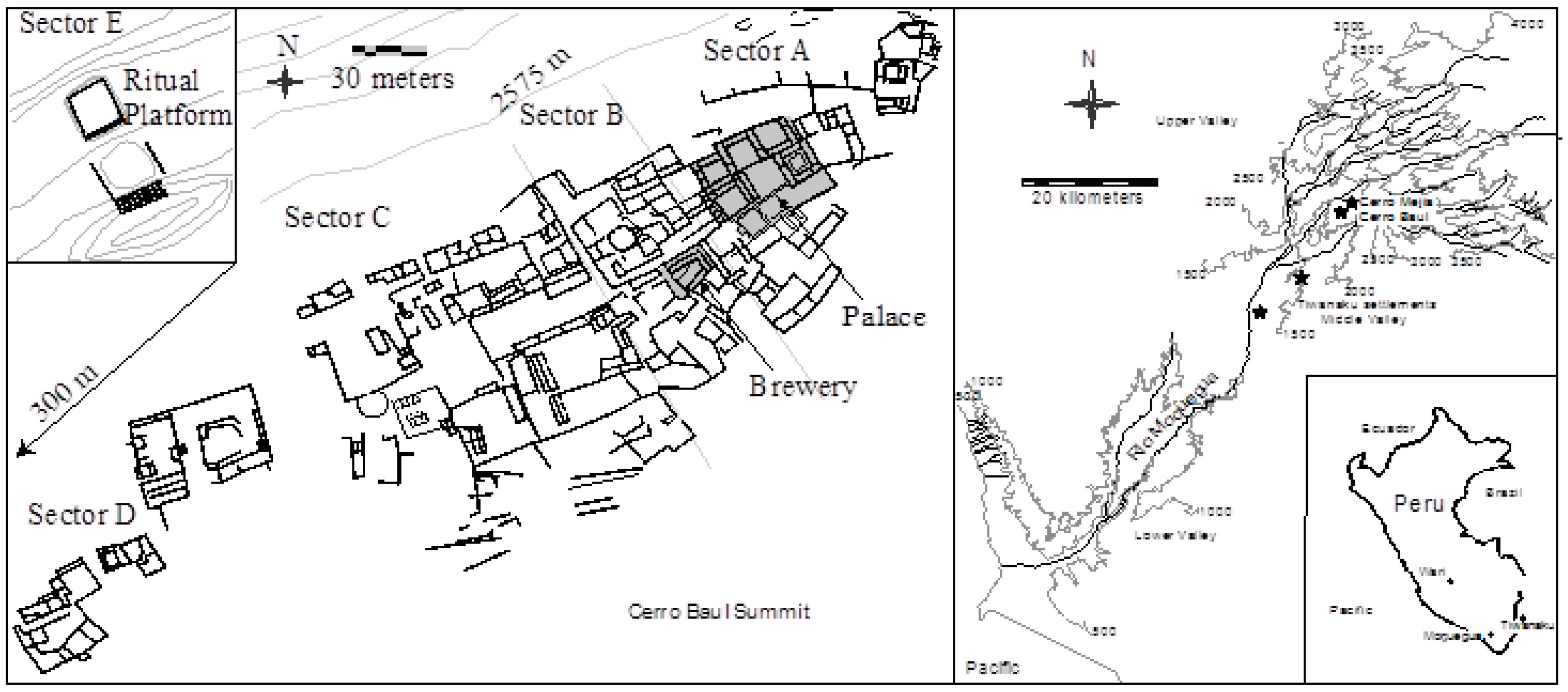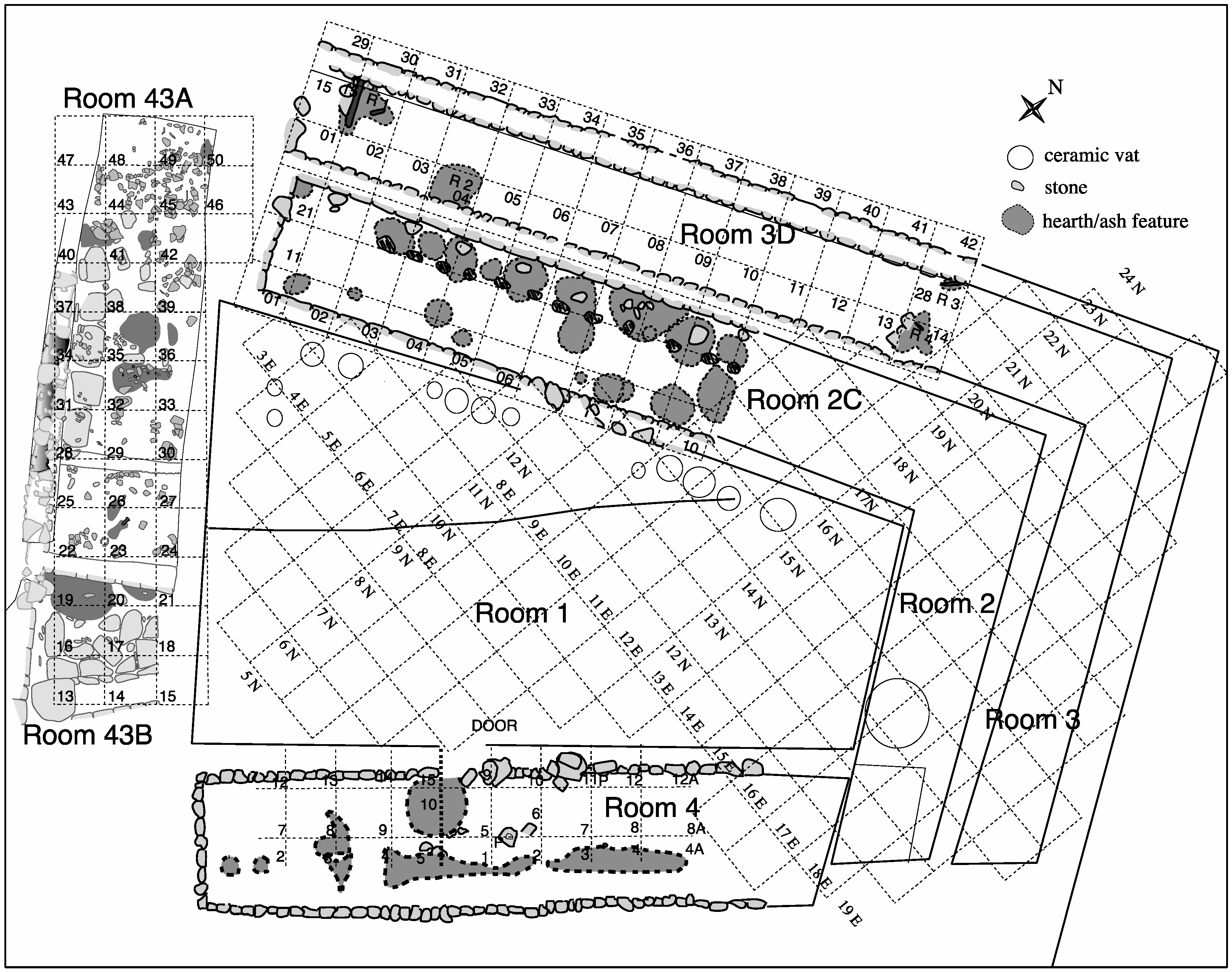Archaeometric Approaches to Defining Sustainable Governance: Wari Brewing Traditions and the Building of Political Relationships in Ancient Peru
Abstract
:1. Introduction
1.1. Cerro Baúl Brewery as Study Focus
1.2. The Brewery Context
2. Materials and Methods
2.1. Ceramic Paste Analysis Methods
2.2. Residue Analysis Methods
3. Results
3.1. Ceramic Paste Sourcing Results
3.2. Residue Analysis Results
4. Discussion
Author Contributions
Funding
Acknowledgments
Conflicts of Interest
References
- Stein, G. Segmentary States and Organizational Variation in Early Complex Societies: A Rural Perspective. In Archaeological Views from the Countryside: Village Communities in Early Complex Societies; Schwartz, G., Falconer, S., Eds.; Smithsonian Institution Press: Washington, DC, USA, 1994; pp. 10–18. [Google Scholar]
- Cook, A.; Glowacki, M. Pots, Politics, and Power. In The Archaeology and Politics of Food and Feasting in Early States and Empires; Bray, T., Ed.; Springer: Boston, MA, USA, 2003; pp. 173–202. [Google Scholar]
- Nash, D.J. Art and Elite Political Machinations in the Middle Horizon Andes. In Images in Action: The Southern Andean Iconographic Series; Isbell, W., Uribe, M., Tiballi, A., Zegarra, E., Eds.; UCLA-Cotsen Institute of Archaeology Press: Los Angeles, CA, USA, 2018; pp. 481–499. [Google Scholar]
- Nash, D.; Williams, P.R. As Wari Weakened: Ritual Transitions in the Terminal Middle Horizon of Moquegua, Peru. In Ritual during Periods of Decline, Collapse, and Regeneration in Archaic States; Murphy, J., Ed.; Routledge: London, UK, 2019; under review. [Google Scholar]
- Williams, P.R.; Nash, D.J. Sighting the Apu: A GIS Analysis of Wari Imperialism and the Worship of Mountain Peaks. World Archaeol. 2006, 38, 455–468. [Google Scholar] [CrossRef]
- Nash, D. Craft Production as an Empowering Strategy in an Emerging Empire. J. Anthropol. Res. 2019. under review. [Google Scholar]
- Goldstein, D.J.; Coleman, R.C.; Williams, P.R. Reconstructing Middle Horizon (500–1000 C.E.) Social Dynamics through Paleoethnobotanical Interpretations of Fermented Beverage Production and Consumption at Cerro Baúl, Moquegua, Perú. In Drink, Power, and Society in the Andes; Jennings, J., Bowers, B., Eds.; University of Florida Press: Gainesville, FL, USA, 2009; pp. 133–166. [Google Scholar]
- Nash, D. The art of feasting: building an empire with food and drink. In Wari: Lords of the Ancient Andes; Bergh, S., Ed.; Cleveland Museum of Art: Cleveland, OH, USA, 2012; pp. 82–99. [Google Scholar]
- Goldstein, D.J.; Coleman, R.C. Schinus molle L. (Anacardiaceae) chicha production in the Central Andes. Econ. Bot. 2004, 58, 523–529. [Google Scholar] [CrossRef]
- Moseley, M.; Nash, D.; Williams, P.; DeFrance, S.; Miranda, A.; Ruales, M. Burning Down the Brewery: Excavation and Evacuation of an Ancient Imperial Colony at Cerro Baúl, Perú. Proc. Natl. Acad. Sci. USA 2005, 102, 17264–17271. [Google Scholar] [CrossRef] [PubMed]
- Nash, D.; Williams, P.R. Architecture and Power on the Wari—Tiwanaku Frontier. Archaeol. Papers Am. Anthropol. Assoc. 2005, 14, 151–174. [Google Scholar] [CrossRef]
- Williams, P.R. Cerro Baúl: A Wari Center on the Tiwanaku Frontier. Lat. Am. Antiq. 2001, 12, 67–83. [Google Scholar] [CrossRef]
- Williams, P.R. Tiwanaku: A Cult of the Masses. In Visions of Tiwanaku; Vranich, A., Stanish, C., Eds.; Cotsen Institute of Archaeology at UCLA: Los Angeles, CA, USA, 2013; pp. 27–40. [Google Scholar]
- Williams, P.R.; Nash, D. Imperial Interaction in the Andes: Wari and Tiwanaku at Cerro Baúl. In Andean Archaeology; Isbell, W., Silverman, H., Eds.; Plenum: New York, NY, USA, 2002; pp. 243–265. [Google Scholar]
- Nash, D. Fine Dining and Fabulous Atmosphere: Feasting Facilities and Political Interaction in the Wari Realm. In Inside Ancient Kitchens: New Directions in the Study of Daily Meals and Feasts; Klarich, E., Ed.; University Press of Colorado: Boulder, CO, USA, 2010; pp. 83–110. [Google Scholar]
- Sayre, M.; Goldstein, D.; Whitehead, W.; Williams, P.R. A Marked Preference: Chicha de Molle and Wari State Consumption Practices. Ñawpa Pacha 2012, 32, 231–258. [Google Scholar] [CrossRef]
- Williams, P.R. Wari and Tiwanaku Borderlands. In Tiwanaku: Papers from the 2005 Mayer Center Symposium; Young-Sanchez, M., Ed.; Denver Art Museum: Denver, CO, USA, 2009; pp. 211–224. [Google Scholar]
- Nash, D.; Williams, P.R. Wari Political Organization: The Southern Periphery. In Andean Civilization: A Tribute to Michael E. Moseley; Marcus, J., Williams, P.R., Eds.; Cotsen Institute of Archaeology Press, UCLA: Los Angeles, CA, USA, 2009; pp. 257–276. [Google Scholar]
- Williams, P.; Nash, D.; Cook, A.; Isbell, W.; Speakman, R. Wari Ceramic Production in the Heartland and Provinces. In Ceramics of the Indigenous Cultures of South America: Studies of Production and Exchange through Compositional Analysis; Glascock, M., Neff, H., Vaughn, K., Eds.; UNM Press: Albuquerque, NM, USA, 2019; pp. 125–133. [Google Scholar]
- Dussubieux, L.; Golitko, M.; Williams, P.R.; Speakman, R.J. LA-ICP-MS analysis applied to the characterization of Peruvian Wari ceramics. In Archaeological Chemistry: Analytical Techniques and Archaeological Interpretation; Glascock, M., Popelka-Filcoff, R., Speakman, R.J., Eds.; American Chemical Society Symposium Series 968; American Chemical Society Symposium: Washington, DC, USA, 2007; pp. 349–363. [Google Scholar]
- Sharratt, N.; Golitko, M.; Williams, P.R. Pottery Production, Regional Exchange and State Collapse during the Middle Horizon: LA-ICP-MS analyses of Tiwanaku Pottery in the Moquegua Valley, Perú. J. Field Archaeol. 2015, 40, 397–412. [Google Scholar] [CrossRef]
- Sharratt, N.; Golitko, M.; Williams, P.R.; Dussubieux, L. Ceramic Production during the Middle Horizon: Wari and Tiwanaku clay procurement in the Moquegua Valley, Peru. Geoarchaeology 2009, 24, 792–820. [Google Scholar] [CrossRef]
- Glascock, M. Compositional Analysis of Archaeological Ceramics. In Ceramics of the Indigenous Cultures of South America: Studies of Production and Exchange through Compositional Analysis; Glascock, M., Neff, H., Vaughn, K., Eds.; UNM Press: Albuquerque, NM, USA, 2019. [Google Scholar]
- Gratuze, B.; Blet-Lemarquand, M.; Barrandon, J.N. Mass spectrometry with laser sampling: A new tool to characterize archaeological materials. J. Radioanal. Nucl. Chem. 2001, 247, 645–656. [Google Scholar] [CrossRef]
- Cody, R.B.; Dane, A.J. Direct Analysis in Real Time (DART). In Ambient Ionization Mass Spectrometry; Domin, M., Cody, R.B., Eds.; Royal Society of Chemistry: Cambridge, UK, 2015. [Google Scholar]
- Hopkins, J.; Armitage, R.A. Characterizing Organic Residues on Ceramics by Direct Analysis in Real Time Time-of-Flight Mass Spectrometry. In Collaborative Endeavors in the Chemical Analysis of Art and Cultural Heritage Materials; Lang, P.L., Armitage, R.A., Eds.; American Chemical Society: Washington, DC, USA, 2012; Volume 1103, pp. 131–142. [Google Scholar]
- Reaxys. Schinus Molle (Isolation from Natural Product); Elsevier: Amsterdam, The Netherlands, 2014. [Google Scholar]
- Londoño, A.C.; Williams, P.R.; Hart, M.L. A change in landscape: Lessons learned from abandonment of ancient Wari agricultural terraces in Southern Peru. J. Environ. Manag. 2017, 202, 532–542. [Google Scholar] [CrossRef] [PubMed]
- Williams, P.R. A Re-examination of Disaster Induced Collapse in the Case of the Andean Highland States: Wari and Tiwanaku. World Archaeol. 2002, 33, 361–374. [Google Scholar] [CrossRef]









| Context | N | Lab Numbers | Method | Group(s) Assigned |
|---|---|---|---|---|
| Baúl brewery (elite) | 20 | PRW002,4–8,11, 13–14, 16, 20, 27, 29–32, 36, 38–40 | INAA | Baúl group (90%) Mejia A (5%) Unassigned (5%) |
| Baúl palace and consumption (elite) | 19 | PRW101–102, 104, 106, 109, 112–113, 118, 120, 123, 125, 131, 133, 136, 144–145, 147–148, 150 | INAA & LA-ICP-MS | Baúl group (100%) |
| Other Baúl summit (elite) | 41 | PRW001, 3, 9–10, 12, 15, 17–19, 21–26, 28, 33–35, 37,103, 105, 107–108, 110–111, 114–117, 119, 121–122, 124, 126, 130, 132, 134, 138, 143, 149 | INAA | Baúl group (46%) Mejia A, B, D, E, or G (29%) Unassigned (25%) |
| Formative sites (local) | 10 | PRW183–192 | INAA | Mejia A (40%) Mejia D (30%) Unassigned (30%) |
| Cerro Mejia (local) | 51 | PRW046–096 | INAA | Mejia A (24%) Mejia B (31%) Mejia D, G, or F (12%) Baúl Group (6%) Unassigned (27%) |
| Baúl slopes (local) | 44 | PRW099–100, 127–129, 135, 137, 139-142, 146, 151–182 | INAA | Mejia A (52%) Mejia B, C, D, E, or F (32%) Baúl Group (2%) Unassigned (14%) |
| Tiwanaku sites in Moquegua | 29 | TW001–029 | LA-ICP-MS | Local Tiwanaku (86%) Unassigned (14%) |
| Wari heartland | 29 | PRW195–223 | INAA & LA-ICP-MS | Wari-1 (55%) Wari-2 (21%) Wari-3 (10%) Mejia A (4%) Unassigned (10%) |
| Chicha de jora (maize) | ||||
| Compound | Formula | Measured Mass | Calculated Mass | Intensity |
| Methyl gallate | C8H8O5 | 183.024 | 183.029 | trace |
| Shikimic acid | C7H10O5 | 173.041 | 173.045 | trace |
| Chicha de molle | ||||
| Compound | Formula | Measured Mass | Calculated Mass | Intensity |
| Safrole | C10H10O2 | 161.067 | 161.060 | low |
| Gallic acid | C7H6O5 | 169.016 | 169.014 | trace |
| Terebanene, teredenene, or β-spathulene | C15H22 | 201.156 | 201.164 | trace |
| Palustrol/rosifoliol/shyobunol | C15H26O | 221.192 | 221.191 | low |
| Compound | Formula | Measured mass, [M−H]− | Calculated Mass, [M−H]− | CB04-01-0530 | CB89-1110 | CB89-1200 | CB89-1221 | CB89-1233 |
|---|---|---|---|---|---|---|---|---|
| simiarenol | C30H50O | 425.376 ± 0.002 | 425.378 | nd | nd | + | + | nd |
| masticadienoic acid (terebinthone) or moronic acid | C30H46O | 453.345± 0.000 | 453.337 | nd | + | nd | nd | + |
| hydroxymasticadienoic acid | C30H48O3 | 455.348 ± 0.002 | 455.353 | nd | nd | + | nd | nd |
| terebanene, teredenene, or β-spathulene | C15H22 | 201.163 ± 0.003 | 201.164 | nd | + | nd | + | ++ |
| safrole | C10H10O2 | 161.061 ± 0.009 | 161.060 | nd | nd | nd | + | + |
© 2019 by the authors. Licensee MDPI, Basel, Switzerland. This article is an open access article distributed under the terms and conditions of the Creative Commons Attribution (CC BY) license (http://creativecommons.org/licenses/by/4.0/).
Share and Cite
Williams, P.R.; J. Nash, D.; Henkin, J.M.; Armitage, R.A. Archaeometric Approaches to Defining Sustainable Governance: Wari Brewing Traditions and the Building of Political Relationships in Ancient Peru. Sustainability 2019, 11, 2333. https://doi.org/10.3390/su11082333
Williams PR, J. Nash D, Henkin JM, Armitage RA. Archaeometric Approaches to Defining Sustainable Governance: Wari Brewing Traditions and the Building of Political Relationships in Ancient Peru. Sustainability. 2019; 11(8):2333. https://doi.org/10.3390/su11082333
Chicago/Turabian StyleWilliams, Patrick Ryan, Donna J. Nash, Joshua M. Henkin, and Ruth Ann Armitage. 2019. "Archaeometric Approaches to Defining Sustainable Governance: Wari Brewing Traditions and the Building of Political Relationships in Ancient Peru" Sustainability 11, no. 8: 2333. https://doi.org/10.3390/su11082333





